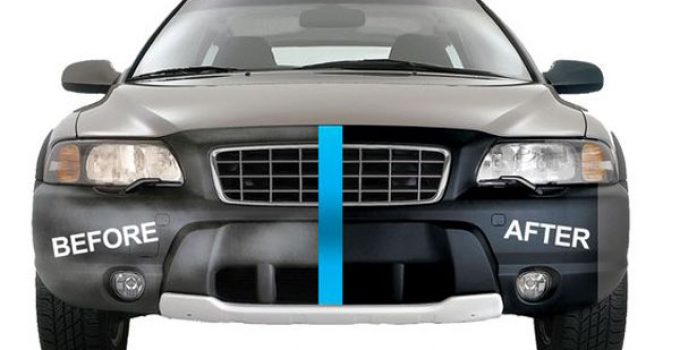Do you have a car with fading plastic parts, and is it making your car look older than it is? This is very common when you live in regions with extreme weather conditions, harsh winds, or excessive exposure to sunlight.
Due to all of these reasons, the plastic parts of the exterior of the car fades at a faster rate than the metal parts. If this is your condition, then worry not friends because you are in the right place.
This article tells you how to restore faded plastic bumpers and make your car look as good as new.
Let’s dive in.
Why Do Plastics in the Car Fade?
If you look around in your car, you will see that many things are made of plastic. The window trims, cup holders, bumpers, etc. are all made of plastic. When you purchase the car, however, it is hard to tell the difference between the metal and the plastic parts because all of them look shiny and polished at that time.
But over the color on the plastic parts become unblemished as they fade, dry out, crack or even collect dust, dirt, and grime, grease, or food particles. The plastic on the outside of your car gets exposed to elements such as rain, salt, road sand, dust, bird poop, and so many other things which are extremely damaging.
Another reason why plastics fade is for the exposure to UV rays and sunlight. It is, in fact, the number one cause for plastic color fading in cars. If your car is parked out in the sunlight for hours, you can expect the color of the plastics of your car to fade very quickly.
The color of the plastic parts may fade due to extreme weather conditions like deserts or ice lands.
How to Restore Faded Plastic Bumpers
Once the plastics in your car body has faded, there is nothing left for you to do except restore it. There are three methods mentioned below that will teach you how to restore faded plastic bumpers.
Method 1: Rubbing Oil on Faded Plastic
Let’s go through the step-by-step method.
Step 1: Clean Your Bumper
First off, wash your bumper with soap and warm water, so that the oil can be absorbed into a clean surface. After washing thoroughly, dry it using a towel so that the oil and the water don’t mix, and the oil doesn’t slip off.
Step 2:Cover Your Bumper with Oil
Take a clean piece of cotton and pour a coin-sized amount of olive oil on the cloth. When you apply the olive oil, it can help restore the original color of the plastic by clearing up the faded parts.
Apply the oil thoroughly through the bumper covering every inch. No need to pour too much of the oil at one go, you can always add some water if you run short. If you don’t have olive oil, you can use baby oil or linseed oil as substitutes.
Step 3: Focus on the Dogged Areas of Discoloration
Target the most affected areas and massage the oil into those areas on the bumpers, by rubbing the cloth back and forth for several minutes. Make sure you don’t make the entire space oily because it won’t be safe for you. You might want to get up or move, and you might slip on the oil. So you need to be careful.
Step 4:Clean the Oil
After rubbing the oil for some time, take a dry piece of a washcloth and start wiping the plastic in circular movements. The trick is to apply heavy pressure as you do it so that you can get rid of all the grease off the plastic and give it a nice shiny glow.
Step 5: Repeat the Process Again if Needed
After you have rubbed the oil off, inspect the bumper. If there are patches of areas where the oil didn’t dissolve, then repeat the entire process, targeting those stubborn areas.
Method 2: Using a Heat Gun
It must be made clear that using a heat gun is not a permanent solution. When you use the heat gun, the natural oils from the plastic come out and can restore its luster; however, it will eventually fade with use.
How long the plastic will stay shiny will depend on your use of the car and the conditions the car has to go through. The harsher the conditions and the more you use your car, the quicker the decolonization will start.
Step 1: Cover the Surrounding Parts with Tarp
Before actually using the heat gun, cover the non-plastic parts around the bumper with a tarp because using a heat gun on the non-plastic parts can have the opposite effect there, and it could end up discoloring those areas.
Step 2:Wash the Bumper
Clean and dry the bumper with soap and water so that when you use the heat gun, the dust or debris accumulated on it does not catch on fire.
Step 3: Use the Heat Gun
Now it’s finally time to use the heat gun. Hold it a few inches away from the bumper and turn it on. Make sure you don’t hold the heat gun in one place for too long, or it will end up melting the plastic. Move it around the entire bumper making small circles.
Step 4:Repeat the Process Where Needed
After a while, turn the heat gun off and inspect the bumper to concentrate on those stubborn parts.
Method 3: Paint over the Plastic
We’ll walk you through the entire process in the easiest manner.
Step 1:Rinse the Bumper
Clean the bumper by washing it with soap and water. Then dry the surface using a clean, fresh cloth. This is because the paint will stick to the surface even if the surface is clean and smooth.
Step 2:Sand Your Bumper
Sand the surface of your bumper to give it a nice smooth texture so that the paint sticks. You can use a 220-grit sanding block for this. Sand the bumper properly and then get rid of the dust using a brush or cloth.
Step 3:Apply a Coat of Primer
Before you apply the paint, it is recommended to apply a coat of primer to help the paint stick of the bumper properly. Apply the primer evenly throughout the bumper and leave it to dry. How long you leave it to dry depends on the primer you got.
There should be instructions in the manual, so just follow that, but usually, it is between half an hour to an hour.
Step 4:Use the Spray Paint
Now it’s time for the fun part. Take the spray paint and start spraying over the bumper.
You should know the proper ways of painting a plastic bumper.Make sure you hold the nozzle at least 12-18 inches away from the surface. Move along the bumper, spraying it in overlapping strokes until you cover the whole surface. To strengthen the color, you must apply 3 to 4 coats of color. Put one coat and let it dry for about an hour before you apply the next coat.
Step 5:Apply a Coat of Primer Again to Safeguard the Paint
Now that your bumper is painted, you must apply a layer of primer to help protect the color. This will prevent and delay the dulling process.
How to Prevent the Faded of Plastic Bumpers
Now that we know how to restore the faded plastic and know that it is quite some work, we should ensure that our bumpers don’t get discolored easily in the first place. You can follow the following tips to make help you take care of the plastic parts of your cars.
Clean Your Bumper Regularly
For this, you can simply use soap and water. There are some sophisticated plastic cleaners in the market, you can also use one of those. But make sure you don’t leave on the chemicals on the plastic for too long otherwise, it will have the opposite effect and end up discoloring your bumper.
- Don’t Use Abrasive Solutions
Don’t scrub the plastic with any tools or abrasive cleaning solution or use acidic homemade cleaning solutions. This will end up harming the paint and causing the dulling of the color.
Add Waxing to Your Car Wash
It’s not that expensive, and the wax will help protect the color of the plastic parts in your car.
Wipe Any Fingerprints Away Immediately
Don’t just turn your part on your car if you see something unusual and small, like fingerprints. Wipe them away as soon as you notice them.
Conclusion
See how easy it is to make your car look like its brand new? All it takes is some dedication and a little effort.
I would like to remind you guys to wear your protective goggles and gloves when you are working on your bumper. No matter how insignificant it may seem, it is never wrong to be safe and careful. Now that you know how easy it is to restore your faded plastic bumper, let’s get going and make our cars shiny again.And if your paint isn’t faded , it’s just chipped off a bit , you can try the car paint chip repair kits in the market.



